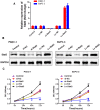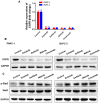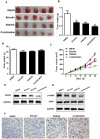Emodin sensitizes human pancreatic cancer cells to EGFR inhibitor through suppressing Stat3 signaling pathway
- PMID: 31572001
- PMCID: PMC6756157
- DOI: 10.2147/CMAR.S221877
Emodin sensitizes human pancreatic cancer cells to EGFR inhibitor through suppressing Stat3 signaling pathway
Abstract
Background: Excessive expression of EGFR is closely related to tumor formation, transfer and deterioration, which has attracted much attention. EGFR overexpression may be detected in up to 90% of pancreatic tumors. However, drug resistance of EGFR inhibitors targeting treatment severely limits its clinical application.
Methods: In this study, Western blotting was used to detect the expression of p-Stat3, EGFR, Bcl-2, cleaved-caspase3 and Bax. Cell apoptosis was evaluated via flow cytometry. The colon assay and MTT assay were applied for detecting the cell proliferation in vitro. The xenograft mouse model was used to examine the cell proliferation in vivo.
Results: Emodin remarkably enhanced the anti-cancer effect of EGFR inhibitor on pancreatic cancer cells. In addition, emodin promoted afatinib-induced apoptosis by inhibiting the Stat3 signaling pathway. Meanwhile, siRNAs against Stat3 significantly increased the apoptosis of pancreatic cancer cells. EGFR inhibitor promoted phosphorylation of Stat3 in pancreatic cancer cells. Interestingly, emodin combined with EGFR inhibitor inhibited the proliferation of pancreatic cancer cells in vitro. The tumor xenograft mice model was further confirmed that emodin possessed a synergy anticancer effect with afatinib on pancreatic cancer cells by regulating the Stat3 expression.
Conclusion: These results indicate that the combination of emodin with EGFR inhibitor is an effective therapeutic strategy to sensitize human pancreatic cancer.
Keywords: EGFR inhibitors; Stat3; afatinib; pancreatic cancer.
© 2019 Wang et al.
Conflict of interest statement
The authors report no conflicts of interest in this work.
Figures






Similar articles
-
Rhein sensitizes human pancreatic cancer cells to EGFR inhibitors by inhibiting STAT3 pathway.J Exp Clin Cancer Res. 2019 Jan 23;38(1):31. doi: 10.1186/s13046-018-1015-9. J Exp Clin Cancer Res. 2019. PMID: 30674340 Free PMC article.
-
Alantolactone sensitizes human pancreatic cancer cells to EGFR inhibitors through the inhibition of STAT3 signaling.Mol Carcinog. 2019 Apr;58(4):565-576. doi: 10.1002/mc.22951. Epub 2019 Jan 4. Mol Carcinog. 2019. PMID: 30520143
-
Rhein sensitizes human colorectal cancer cells to EGFR inhibitors by inhibiting STAT3 pathway.Onco Targets Ther. 2019 Jul 3;12:5281-5291. doi: 10.2147/OTT.S206833. eCollection 2019. Onco Targets Ther. 2019. PMID: 31308698 Free PMC article.
-
STAT3 inhibitor BBI608 enhances the antitumor effect of gefitinib on EGFR-mutated non-small cell lung cancer cells.Hum Cell. 2021 Nov;34(6):1855-1865. doi: 10.1007/s13577-021-00582-4. Epub 2021 Aug 9. Hum Cell. 2021. PMID: 34370268
-
Synergistic activity of agents targeting growth factor receptors, CDKs and downstream signaling molecules in a panel of pancreatic cancer cell lines and the identification of antagonistic combinations: Implications for future clinical trials in pancreatic cancer.Oncol Rep. 2020 Dec;44(6):2581-2594. doi: 10.3892/or.2020.7822. Epub 2020 Oct 22. Oncol Rep. 2020. PMID: 33125153 Free PMC article.
Cited by
-
A mannitol-modified emodin nano-drug restores the intestinal barrier function and alleviates inflammation in a mouse model of DSS-induced ulcerative colitis.Chin Med. 2023 Aug 11;18(1):98. doi: 10.1186/s13020-023-00801-0. Chin Med. 2023. PMID: 37568235 Free PMC article.
-
Emodin-Conjugated PEGylation of Fe3O4 Nanoparticles for FI/MRI Dual-Modal Imaging and Therapy in Pancreatic Cancer.Int J Nanomedicine. 2021 Nov 6;16:7463-7478. doi: 10.2147/IJN.S335588. eCollection 2021. Int J Nanomedicine. 2021. PMID: 34785894 Free PMC article.
-
Cancer Chemoprevention: A Strategic Approach Using Phytochemicals.Front Pharmacol. 2022 Jan 13;12:809308. doi: 10.3389/fphar.2021.809308. eCollection 2021. Front Pharmacol. 2022. PMID: 35095521 Free PMC article. Review.
-
The Health Benefits of Emodin, a Natural Anthraquinone Derived from Rhubarb-A Summary Update.Int J Mol Sci. 2021 Sep 1;22(17):9522. doi: 10.3390/ijms22179522. Int J Mol Sci. 2021. PMID: 34502424 Free PMC article. Review.
-
Emodin Interferes With AKT1-Mediated DNA Damage and Decreases Resistance of Breast Cancer Cells to Doxorubicin.Front Oncol. 2021 Feb 9;10:588533. doi: 10.3389/fonc.2020.588533. eCollection 2020. Front Oncol. 2021. Retraction in: Front Oncol. 2023 Dec 07;13:1337635. doi: 10.3389/fonc.2023.1337635. PMID: 33634018 Free PMC article. Retracted.
References
-
- Zhou Y, Cui J, Du H. Autoantibody-targeted TAAs in pancreatic cancer: a comprehensive analysis. Pancreatol. 2019;19(5):760–768. - PubMed
LinkOut - more resources
Full Text Sources
Research Materials
Miscellaneous

